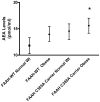Biomarkers of endocannabinoid system activation in severe obesity
- PMID: 20098695
- PMCID: PMC2808340
- DOI: 10.1371/journal.pone.0008792
Biomarkers of endocannabinoid system activation in severe obesity
Abstract
Background: Obesity is a worldwide epidemic, and severe obesity is a risk factor for many diseases, including diabetes, heart disease, stroke, and some cancers. Endocannabinoid system (ECS) signaling in the brain and peripheral tissues is activated in obesity and plays a role in the regulation of body weight. The main research question here was whether quantitative measurement of plasma endocannabinoids, anandamide, and related N-acylethanolamines (NAEs), combined with genotyping for mutations in fatty acid amide hydrolase (FAAH) would identify circulating biomarkers of ECS activation in severe obesity.
Methodology/principal findings: Plasma samples were obtained from 96 severely obese subjects with body mass index (BMI) of > or = 40 kg/m(2), and 48 normal weight subjects with BMI of < or = 26 kg/m(2). Triple-quadrupole mass spectroscopy methods were used to measure plasma ECS analogs. Subjects were genotyped for human FAAH gene mutations. The principal analysis focused on the FAAH 385 C-->A (P129T) mutation by comparing plasma ECS metabolite levels in the FAAH 385 minor A allele carriers versus wild-type C/C carriers in both groups. The main finding was significantly elevated mean plasma levels of anandamide (15.1+/-1.4 pmol/ml) and related NAEs in study subjects that carried the FAAH 385 A mutant alleles versus normal subjects (13.3+/-1.0 pmol/ml) with wild-type FAAH genotype (p = 0.04), and significance was maintained after controlling for BMI.
Conclusions/significance: Significantly increased levels of the endocannabinoid anandamide and related NAEs were found in carriers of the FAAH 385 A mutant alleles compared with wild-type FAAH controls. This evidence supports endocannabinoid system activation due to the effect of FAAH 385 mutant A genotype on plasma AEA and related NAE analogs. This is the first study to document that FAAH 385 A mutant alleles have a direct effect on elevated plasma levels of anandamide and related NAEs in humans. These biomarkers may indicate risk for severe obesity and may suggest novel ECS obesity treatment strategies.
Conflict of interest statement
Figures

Similar articles
-
Circulating Endocannabinoids and the Polymorphism 385C>A in Fatty Acid Amide Hydrolase (FAAH) Gene May Identify the Obesity Phenotype Related to Cardiometabolic Risk: A Study Conducted in a Brazilian Population of Complex Interethnic Admixture.PLoS One. 2015 Nov 11;10(11):e0142728. doi: 10.1371/journal.pone.0142728. eCollection 2015. PLoS One. 2015. PMID: 26561012 Free PMC article.
-
Activation of the peripheral endocannabinoid system in human obesity.Diabetes. 2005 Oct;54(10):2838-43. doi: 10.2337/diabetes.54.10.2838. Diabetes. 2005. PMID: 16186383 Free PMC article.
-
Reduced cellular expression and activity of the P129T mutant of human fatty acid amide hydrolase: evidence for a link between defects in the endocannabinoid system and problem drug use.Hum Mol Genet. 2004 Sep 15;13(18):2113-9. doi: 10.1093/hmg/ddh216. Epub 2004 Jul 14. Hum Mol Genet. 2004. PMID: 15254019
-
Partial QSAR analysis of some selected natural inhibitors of FAAH suggests a working hypothesis for the development of endocannabinoid-based drugs.Curr Drug Targets CNS Neurol Disord. 2005 Dec;4(6):709-14. doi: 10.2174/156800705774933096. Curr Drug Targets CNS Neurol Disord. 2005. PMID: 16375688 Review.
-
N-acylethanolamine metabolism with special reference to N-acylethanolamine-hydrolyzing acid amidase (NAAA).Prog Lipid Res. 2010 Oct;49(4):299-315. doi: 10.1016/j.plipres.2010.02.003. Epub 2010 Feb 10. Prog Lipid Res. 2010. PMID: 20152858 Review.
Cited by
-
385 C/A polymorphism of the fatty acid amide hydrolase gene is associated with metabolic syndrome in the Chinese Han population.Arch Med Sci. 2011 Jun;7(3):423-7. doi: 10.5114/aoms.2011.23406. Epub 2011 Jul 11. Arch Med Sci. 2011. PMID: 22295023 Free PMC article.
-
Protective effects of elevated anandamide on stress and fear-related behaviors: translational evidence from humans and mice.Mol Psychiatry. 2020 May;25(5):993-1005. doi: 10.1038/s41380-018-0215-1. Epub 2018 Aug 17. Mol Psychiatry. 2020. PMID: 30120421
-
A covering method for detecting genetic associations between rare variants and common phenotypes.PLoS Comput Biol. 2010 Oct 14;6(10):e1000954. doi: 10.1371/journal.pcbi.1000954. PLoS Comput Biol. 2010. PMID: 20976246 Free PMC article.
-
Circulating Endocannabinoids and N-Acylethanolamines in Individuals with Cannabis Use Disorder-Preliminary Findings.Brain Sci. 2023 Sep 27;13(10):1375. doi: 10.3390/brainsci13101375. Brain Sci. 2023. PMID: 37891745 Free PMC article.
-
Cannabinoid type 1 receptor availability in the amygdala mediates threat processing in trauma survivors.Neuropsychopharmacology. 2014 Oct;39(11):2519-28. doi: 10.1038/npp.2014.110. Epub 2014 May 12. Neuropsychopharmacology. 2014. Retraction in: Neuropsychopharmacology. 2020 Dec;45(13):2302. doi: 10.1038/s41386-020-00818-1. PMID: 24820537 Free PMC article. Retracted.
References
-
- Mechoulam R. Recent advances in cannabinoid research. Forsch Komplementarmed. 1999;6(Suppl 3):16–20. - PubMed
-
- Di Marzo V, Fontana A, Cadas H, Schinelli S, Cimino G, et al. Formation and inactivation of endogenous cannabinoid anandamide in central neurons. Nature. 1994;372:686–691. - PubMed
-
- Martin BR, Mechoulam R, Razdan RK. Discovery and characterization of endogenous cannabinoids. Life Sci. 1999;65:573–595. - PubMed
-
- Di Marzo V, Melck D, Bisogno T, De Petrocellis L. Endocannabinoids: endogenous cannabinoid receptor ligands with neuromodulatory action. Trends Neurosci. 1998;21:521–528. - PubMed
Publication types
MeSH terms
Substances
Grants and funding
LinkOut - more resources
Full Text Sources
Medical

